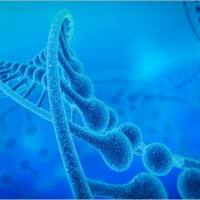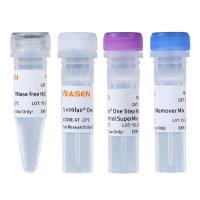Restriction digestion(酶切)
互联网
(adapted from Bruce A. Roe, Department of Chemistry and Biochemistry, The University of Oklahoma, Norman, Oklahoma 73019 broe@ou.edu)
Restriction enzyme digestions are performed by incubating double-stranded DNA molecules with an appropriate amount of restriction enzyme, in its respective buffer as recommended by the supplier, and at the optimal temperature for that specific enzyme. The optimal sodium chloride concentration in the reaction varies for different enzymes, and a set of three standard buffers containing three concentrations of sodium chloride are prepared and used when necessary. Typical digestions included a unit of enzyme per microgram of starting DNA , and one enzyme unit usually (depending on the supplier) is defined as the amount of enzyme needed to completely digest one microgram of double-stranded DNA in one hour at the appropriate temperature. These reactions usually are incubated for 1-3 hours, to insure complete digestion, at the optimal temperature for enzyme activity, typically 37degC. See the Appendix for a listing of restriction sites present in the M13 (pUC) MCS and a listing of various restriction enzymes, incubation conditions and cut sites.
Protocol
1. Prepare the reaction for restriction digestion by adding the following reagents in the order listed to a microcentrifuge tube:
sterile ddH2O q.s (where "q.s." means quantity sufficient)
10X assay buffer one-tenth volume
DNA x μl
restriction enzymundefined y μl (1-10 units per μg DNA )
Total volume z ul
Note: The volume of the reaction depends on the amount and size of the DNA being digested. Larger DNA s should be digested in larger total volumes (between 50-100μl), as should greater amounts of DNA .
Refer to the vendor's catalog for the chart of enzyme activity in a range of salt concentrations to choose the appropriate assay buffer (10X High, 10X Medium, or 10X Low Salt Buffers, or 10X SmaI Buffer for SmaI digestions). Restriction enzymes are purchased from Bethesda Research Laboratories, New England Biolabs, or United States Biochemicals.
2. Gently mix by pipetting and incubate the reaction at the appropriate temperature (typically 37degC) for 1-3 hours.
3. Inactivate the enzyme(s) by heating at 70-100degC for 10 minutes or by phenol extraction (see the vendor's catalog to determine the degree of heat inactivation for a given enzyme). Prior to use in further protocols such as dephosphorylation or ligation, an aliquot of the digestion should be assayed by agarose gel electrophoresis versus non-digested DNA and a size marker, if necessary.








